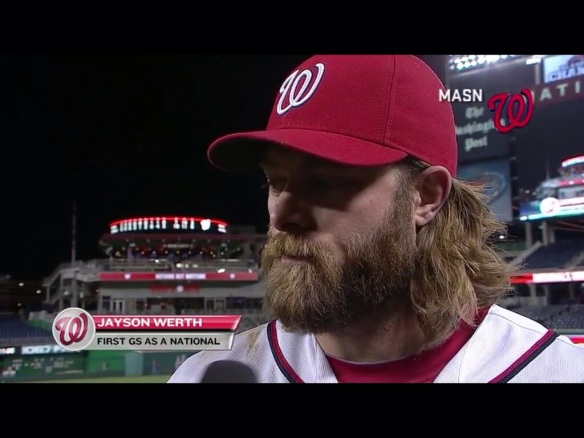As of this writing, Bryce Harper leads the National League in Walks. He leads the National League in Home Runs. He is fourth in the National League in Strikeouts. These, we know, are the Three True Outcomes of a plate appearance. “True,” because they involve only one interaction: the pitcher and the batter, with no intermeddling defense. They are the bedrock of Fielding-Independent Pitching analysis.
Thus far in 2015, 56.6% of Bryce Harper’s plate appearances have ended in a True Outcome. That’s getting up into numbers we haven’t seen in DC since Adam Dunn was a Nat. Yet, surprisingly, doesn’t lead all baseball in what I’m calling True Outcome Percentage (Walks plus strikeouts plus homers, all divided by plate appearances). As of the morning of Saturday, May 9, 2015, your top ten in baseball:
- Joc Pederson, Dodgers, .623
- Bryce Harper, Nationals, .566
- Chris Davis, Orioles, .546 [Leads AL]
- Steven Sousa Jr., Rays, .534
- Colby Rasmus, Astros, .532
- Chris Carter, Astros, .531
- Kris Bryant, Cubs, .511
- Adam LaRoche, White Sox, .490
- George Springer, Astros, .479
Pederson gets the top spot, although Harper has 15 more plate appearances. There’s not a lot to separate Harper and Pederson: Harper has 2 more walks, one less strikeout, and 1 more homer. The other thing that should jump out at you in this quick list is that the Astros dominate the True Outcomes rate leaderboard. but not in a good way: the strikeout is the True Outcome of choice in Houston.
Now, all this got me to thinking: where would Harper’s current .566 True Outcome Rate put him among the All-Time True Outcomes leaders? Bryce Harper’s current Three True Outcomes Rate, if sustained for his career, would put him atop the all-time Three True Outcomes Leaderboard.
And what kind of rarified company would Harper join if his batting approach stays the same? Let’s go down the top ten:
- Jack Cust, .530. [Long-time journeyman AL designated hitter]
- Dave Nicholson, .514 [Preferred outcome: Strikeout. Led AL in strikeouts 1963]
- Russell Branyan, .505, [Russell “the Muscle”: another strikeout machine]
- Chris Carter, .504 [Yes, the same Chris Carter on the Astros, above]
- Adam Dunn, .499 [The man who made the Three True Outcomes famous in DC]
- Rob Deer, .491 [Led AL in strikeouts 4 times!]
- Melvin Nieves, .486 [Preferred outcome: strikeout]
- Mark Reynolds, .486 [and dropping]
- Milt Pappas, .482 [A 2-time All-Star pitcher! And, bonus: as a batter, his most frequent True Outcome was a strikeout–which was also his most frequent True Outcome as a pitcher!]
- Jim Thome, .476, [Another archetypical True Outcome Slugger]
Which leads us to an important point: although True Outcome Rate brings joy to the baseball nerd, it does not tell us that a batter is good at batting. The all-time leaderboard is dominated by strikeout machines. Jim Thome dominates the WAR standings here, with 68.9 WAR over a career that began while we were all reading President George Herbert Walker Bush’s lips because Al Gore hadn’t yet invented the Internet and ended sometime during the bazillionth time I watched “Gangnam Style.” Only Adam Dunn has double-digit WAR (25.7). Mark Reynolds might eventually get there (9.9). Jim Thome only managed 8.6 over a career that began in the George Herbert Walker Bush administration and ended last season. Russell Branyan’s untrue-outcome slugging got him 6.2 WAR. Below that, it’s replacement level or worse batting.
Still, it gives you some perspective as to one possible career path for Harper: a kind of Super WAR Donkey.
Play us out, Spandau Ballet:
Edited, because Distinguished Senators pointed out that I got Thome’s WAR total wrong by a full order of magnitude. I am an idiot.


